This journey is an opportunity to discover many unexpected corners of the city, getting off the beaten tracks and exploring some less popular streets. Starting from the most famous places of Bergamo, you can change direction and look for the most elegant and imaginative facades in Liberty style (the Italian Art Nouveau), where the old boroughs meet the modern city. You will find floral frescoes, refined feminine sculptures, wrought iron masterpieces, numerous works of art and inscriptions. If you are up to listen to a new kind of history, this is the right itinerary for you.
At the foot of the Walls, Lower Bergamo transformed itself starting from the XIX Century, when the modern centre was created and the life of the ancient districts changed for ever. During that time, numerous public buildings were built, along with wide roads and innovative means of transportation, while the old defensive walls surrounding the residential area (called “Muraine”) were demolished.
The residential new districts, where you can now admire the stunning Liberty-style villas and dwellings, were created over the following decades. Who used to live in these fancy houses? Generally, they were middle-class families, entrepreneurs or professionals moving to those areas where the new city was growing.
For what concerns architecture, the Liberty-style made in Bergamo feature the following characteristics:
– the use of cement, modern, inexpensive and easy to process, combined with the wrought iron of gates and gratings
- a rectangular and simple layout in contrast with the lively facade
- the variety of decorative patterns: floral designs, geometries, feminine figures, putti, fruit garlands and sinuous frames coming from Northern Europe taste and from the decorative elements of the past.
If you want to know what makes each facade unique, along with the different personalities of architects and customers, we recommend you five stages.
Beyond Liberty, the thousand sides of Bergamo. Wonderful palaces, churches and monuments from different ages and designed by different architects come together in this amazing itinerary. Read more on: “Le vie del Tempo – the Time Routes”
This journey is an opportunity to discover many unexpected corners of the city, getting off the beaten tracks and exploring some less popular streets. Starting from the most famous places of Bergamo, you can change direction and look for the most elegant and imaginative facades in Liberty style (the Italian Art Nouveau), where the old boroughs meet the modern city. You will find floral frescoes, refined feminine sculptures, wrought iron masterpieces, numerous works of art and inscriptions. If you are up to listen to a new kind of history, this is the right itinerary for you.
At the foot of the Walls, Lower Bergamo transformed itself starting from the XIX Century, when the modern centre was created and the life of the ancient districts changed for ever. During that time, numerous public buildings were built, along with wide roads and innovative means of transportation, while the old defensive walls surrounding the residential area (called “Muraine”) were demolished.
The residential new districts, where you can now admire the stunning Liberty-style villas and dwellings, were created over the following decades. Who used to live in these fancy houses? Generally, they were middle-class families, entrepreneurs or professionals moving to those areas where the new city was growing.
For what concerns architecture, the Liberty-style made in Bergamo feature the following characteristics:
– the use of cement, modern, inexpensive and easy to process, combined with the wrought iron of gates and gratings
- a rectangular and simple layout in contrast with the lively facade
- the variety of decorative patterns: floral designs, geometries, feminine figures, putti, fruit garlands and sinuous frames coming from Northern Europe taste and from the decorative elements of the past.
If you want to know what makes each facade unique, along with the different personalities of architects and customers, we recommend you five stages.
Beyond Liberty, the thousand sides of Bergamo. Wonderful palaces, churches and monuments from different ages and designed by different architects come together in this amazing itinerary. Read more on: “Le vie del Tempo – the Time Routes”
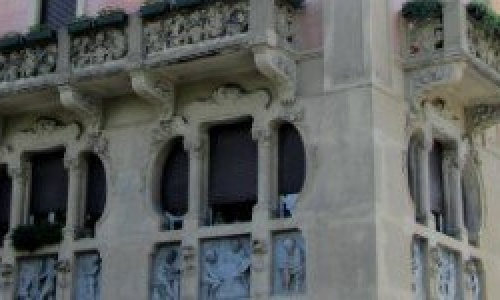
The numerous railway lines of the late XIX Century used to arrive right here, where the main boulevard (the current Viale Papa Giovanni XXIII) leads you from the heart of Lower Bergamo to the Funicular station and the Viale delle Mura. The old “Stazione della Ferrovia delle Valli”, The Valleys Railway Station, overlooks this square: among other things, it used to connect Bergamo with San Pellegrino Terme, a renowned spa town featuring stunning Liberty-style buildings such as the Casino and the Grand Hotel. As you walk along the boulevard, on your left, you will find some buildings designed by Virginio Muzio, the architect who created Casa Paleni – characterized by whimsical decorations - and Palazzo Rezzara or The House of the People. In via Paleocapa, at number 9, the only surviving Liberty building is a villa (1905-1910) with a turret, a lovely veranda and the typical art nouveau decorations featuring fruits and flowers.
The numerous railway lines of the late XIX Century used to arrive right here, where the main boulevard (the current Viale Papa Giovanni XXIII) leads you from the heart of Lower Bergamo to the Funicular station and the Viale delle Mura. The old “Stazione della Ferrovia delle Valli”, The Valleys Railway Station, overlooks this square: among other things, it used to connect Bergamo with San Pellegrino Terme, a renowned spa town featuring stunning Liberty-style buildings such as the Casino and the Grand Hotel. As you walk along the boulevard, on your left, you will find some buildings designed by Virginio Muzio, the architect who created Casa Paleni – characterized by whimsical decorations - and Palazzo Rezzara or The House of the People. In via Paleocapa, at number 9, the only surviving Liberty building is a villa (1905-1910) with a turret, a lovely veranda and the typical art nouveau decorations featuring fruits and flowers.
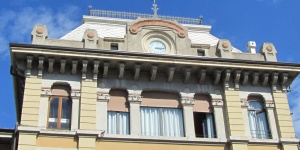
The buildings overlooking the railway square tell the history of never-ending motion, following the pace of technologic innovations. The Ferrovie delle Valli palace housed the station for the trains going towards the Seriana Valley and the Brembana Valley, opened in 1906.
Passengers could also reach the renowned spa town of San Pellegrino. The Liberty-stye Casino and Grand Hotel, built during the same years by Romolo Squadrelli, can also be found (even if less-evident) in the Railway stations. You can see the winged wheel above the central portal and the two side entrances: this symbol was also in the logo of Ferrovie dello Stato, the State Railways.
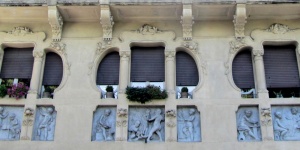
Located at the intersection between the Railway Station square and the current Viale Papa Giovanni XXIII, where the railway had arrived just a few decades before along with the new boulevard, Casa Paleni was in the middle of a dynamic and burgeoning area. This modernity can be noticed by the international style of its decoration, also combined with the personal taste of the architect Virginio Muzio and the commissioning family.
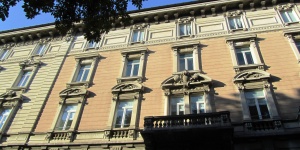
This particular and majestic palace was designed bu Virginio Muzio and Ernesto Pirovano, two of the most active architects of that time in Bergamo. The Union of the Social Catholic Institutions from Bergamo commissioned the two architects, asking them to build a new headquarter for the different association and also funding the palace also by means of a public subscription. The entire architectural complex was named after the president in charge during those years, Niccolò Rezzara.
Many innovative characteristics featured this place: in fact, it used to host a hotel, a restaurant, private houses and shops, a bank, the editorial office and the typography of a the local newspaper, L'Eco di Bergamo. Moreover, there was also the main hall of the Rubini theatre, which was later transformed into the congress centre Papa Giovanni XXIII.
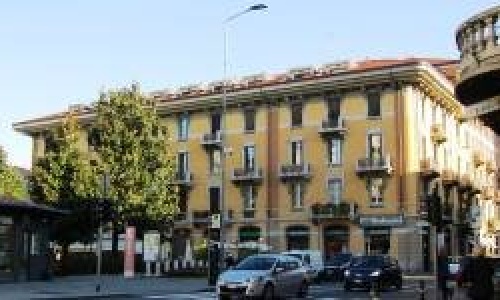
Starting from via Pignolo, walk along via Borgo Palazzo and enjoy the atmosphere of the oldest streets of Lower Bergamo. As you get to Piazza Sant'Anna, you will be surrounded by one of the new districts designed between the late XIX Century and the beginning of the Xxth. Casa Donati Baldelli (1910) consisted of approximately 50 apartments: you can still admire the Liberty-style wrought iron balconies. The customer, Donati, was the manager of a building company very active around this area, and was also a founding member of Fantoni Art School, not far from here.
Starting from via Pignolo, walk along via Borgo Palazzo and enjoy the atmosphere of the oldest streets of Lower Bergamo. As you get to Piazza Sant'Anna, you will be surrounded by one of the new districts designed between the late XIX Century and the beginning of the Xxth. Casa Donati Baldelli (1910) consisted of approximately 50 apartments: you can still admire the Liberty-style wrought iron balconies. The customer, Donati, was the manager of a building company very active around this area, and was also a founding member of Fantoni Art School, not far from here.
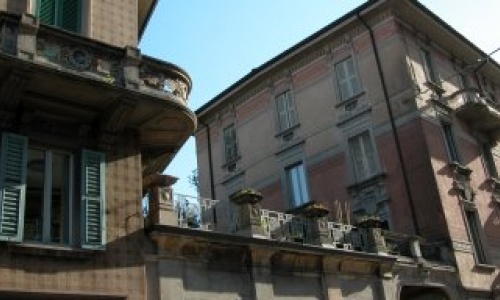
Another borough you cannot miss is Borgo Santa Caterina, not far from Accademia Carrara Picture Gallery. The beautiful Palazzo Gregis (1913) and Palazzo Angelini are located one next to one another, at number 11 and 15. The first one, designed by Luigi Angelini, has a different shape from the above mentioned dwellings. The second one, on the other side, resulted from the enlargement and the restoration of an older building, carried out in 1910-11. You can spot the Liberty decorations on the frames and the balconies. Going back to the Accademia Carrara, you can see other Liberty-stye buildings in via Sauro 1 and at the intersection between via Sauro and via Cesare Battisti.
Another borough you cannot miss is Borgo Santa Caterina, not far from Accademia Carrara Picture Gallery. The beautiful Palazzo Gregis (1913) and Palazzo Angelini are located one next to one another, at number 11 and 15. The first one, designed by Luigi Angelini, has a different shape from the above mentioned dwellings. The second one, on the other side, resulted from the enlargement and the restoration of an older building, carried out in 1910-11. You can spot the Liberty decorations on the frames and the balconies. Going back to the Accademia Carrara, you can see other Liberty-stye buildings in via Sauro 1 and at the intersection between via Sauro and via Cesare Battisti.
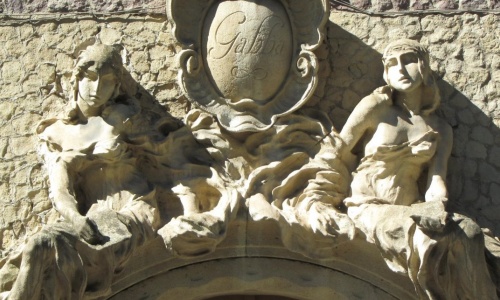
The residential district of Santa Lucia is located right beyond via San'Alessandro: each villa here represents the taste and the personality of its owner. In via Nullo, at the foot of Sant'Alessandro stairs-pathway, you can see the remarkable villa called La Bassiana, which used to belong to the lawyer and senator Bassano Gabba. You can still read the family name on the portal, framed by refined feminine figures. Along the street, Liberty-stye can also be spotted at civic number 42 and 33, both private dwellings built in 1910, when the road was widened by demolishing the preexisting buildings. At the intersection with via Statuto, stop and stare the concrete decorations of Villa Bracciano's turret, created by Luigi Bergonzo. The inscription “Labor omnia vincit” quotes Virgil's “Georgiche”. Nearby, there are also two examples of Liberty-stye non-residentia buildings: the Parish House (approximately 1910), next to the church in via Santa Lucia, and the Headquarter of ”Società Italiana per la distribuzione elettrica” (1910-12) in via Nullo, designed by Luigi Bergonzo: the only remaining buildings belonging to this complex can be recognized by the wide wrought iron windows. If you decide to take via Garibaldi and go to Piazza Pontida, you can also meet other Liberty-stye houses, at civic 19 (Casa Regazzoni, approximately 1908) and 20 (Casa Alessandri, 1908-10).
The residential district of Santa Lucia is located right beyond via San'Alessandro: each villa here represents the taste and the personality of its owner. In via Nullo, at the foot of Sant'Alessandro stairs-pathway, you can see the remarkable villa called La Bassiana, which used to belong to the lawyer and senator Bassano Gabba. You can still read the family name on the portal, framed by refined feminine figures. Along the street, Liberty-stye can also be spotted at civic number 42 and 33, both private dwellings built in 1910, when the road was widened by demolishing the preexisting buildings. At the intersection with via Statuto, stop and stare the concrete decorations of Villa Bracciano's turret, created by Luigi Bergonzo. The inscription “Labor omnia vincit” quotes Virgil's “Georgiche”. Nearby, there are also two examples of Liberty-stye non-residentia buildings: the Parish House (approximately 1910), next to the church in via Santa Lucia, and the Headquarter of ”Società Italiana per la distribuzione elettrica” (1910-12) in via Nullo, designed by Luigi Bergonzo: the only remaining buildings belonging to this complex can be recognized by the wide wrought iron windows. If you decide to take via Garibaldi and go to Piazza Pontida, you can also meet other Liberty-stye houses, at civic 19 (Casa Regazzoni, approximately 1908) and 20 (Casa Alessandri, 1908-10).
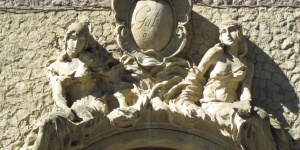
The lawyer and senator Bassano Grappa was the commissioner of this particular villa, as you can see from the family name “Gabba” engraved on the portal.
Going around the block you will admire the imaginative layout pf the entire building, featuring arches, corner towers and curve walls. Even the outer surface is extremely unusual: in fact, it is covered by irregular cobblestones in different shapes and sizes, resembling the tiles of a mosaic. On the other side, the portal is framed by some elegant feminine statues. If you look closer, you will see some craved emblems. Besides the above-mentioned family name, another one contains the name of the villa “La Bassiana” and the year of construction, 1916.
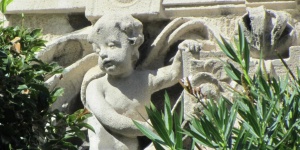
Located at the intersection between via Statuto and via Nullo, Villa Bracciano was one of the first refined palaces built in the early XX Century in the residential district of Santa Lucia.
In fact, it was realized approximately in 1906 following the project of the architect Luigi Bergonzo (father of Alziro Bergonzo, another renowned architect from Bergamo).
The corner turret and its decorative elements still draw the attention of every passer-by. Under the drainpipe, floral frescoes run all around the building. Pilasters, floral patterns and putti surround the windows in an uninterrupted decoration.
Last but not least, the writing “labor omnia vincit”, from Virgil's “Georgiche”.